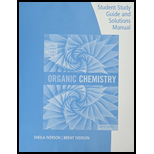
Interpretation:
The role of acid in the Pinacol rearrangement has to be described.
Concept Introduction:
Pinacol rearrangement: For all glycols Pinacol rearrangement occurs. Unsymmetrical vicinal
Step 1: Add proton (protonation of Pinacol using acid catalyst).
Step 2: Break a bond to give a stable molecules or ions (formation of carbocation).
Step 3: 1, 2-shift (migration of substituent from
Step 4: deprotonation occurs (take a proton away).
Trending nowThis is a popular solution!

Chapter 10 Solutions
Student Study Guide and Solutions Manual for Brown/Iverson/Anslyn/Foote's Organic Chemistry, 8th Edition
- For each of the changes listed will the rate of the following chemical reaction increase, decrease, or remain the same? Fe(s)+2HCl(aq)FeCl2(aq)+H2(g) a. the concentration of HCl is decreased b. the iron is ground into a powder c. a catalyst is added to the reaction mixture d. the temperature of the solution is decreasedarrow_forwardIdentify the first chemical step in the production of Portland cement. How is this reaction related to the chemistry that takes place in the carbonation of concrete?arrow_forward. What does it mean to say that all chemical reactions are, to one extent or another, reversible?arrow_forward
- For the simple reaction 2H2(g)+O2(g)2H2O(l)list the types of bonds that must be broken and the types of bonds that must form for the chemical reaction to take place.arrow_forwardWhich statement best describes general equilibrium? Periodic Table and Datasheet Select one: Oa. Equilibrium is reached when the reaction stops. Ob. There is only one set of equilibrium concentrations that equals the K. value. O c. At equilibrium, the rate of the forward reaction is the same as the rate of the reverse reaction. O d. At equilibrium, the total concentration of products equals the total concentration of reactants. The reaction of NO(g) + Cl2(g)=NOCI(g) + Cl(g) tont of 1 1x108 at a partiçular temperature.arrow_forwardWhich statement correctly describes a chemical reaction at equilibrium? 1. The concentrations of the products and reactants are equal. 2. The rate of the forward reaction is less than the rate of the reverse reaction. 3. The rate of the forward reaction is greater than the rate of the reverse reaction. 4. The concentrations of the products and reactants are constant.arrow_forward
- Please help me answer these subunits!arrow_forwardAn endothermic forward reaction will favor a shift to the right, allowing a decrease in the equilibrium constant. This is attributable to the release of heat as compared to exothermic reactions. OA-If the first statement is TRUE and the second statement is FALSE OB-If the first statement is FALSE and the second statement is TRUE C - If both statements are TRUE OD- If both statements are FALSE A temperature change can predict whether a chemical reaction is endothermic or exothermic, considering the amount of heat utilized. This is in consideration with neglecting the effect of energy prior to and after the chemical reaction between the chemical species. OA-If the first statement is TRUE and the second statement is FALSE OB-If the first statement is FALSE and the second statement is TRUE C- If both statements are TRUE OD- If both statements are FALSEarrow_forwardConsider this reaction diagrams where R is reactants and P is products. What would the reaction diagram look like if a catalyst was added?arrow_forward
- Fill in the blanks of the potential/kinetic energy diagramarrow_forwardTRUE OR FALSE. Write T on the space provided if the statement is true. Write F if the statement is false. _6. Catalysts only affect the rate of a reaction. -7. The rate of the forward reaction in a reversible reaction is sometimes greater than the rate of the reverse reaction. 8. Keq of a gaseous solution can be expressed in terms of Kc. 9. If an inert gas is added to a system at equilibrium, the reaction will shift to the direction of fewer molecules. _10. Pressure and volume affect a gaseous system in equilibrium in the same manner.arrow_forward23. What happens when a chemical reaction reaches equilibrium? The amounts of reactants and products remain constant because the reaction stops. The reaction stops because the concentration of reactants is too low to sustain it. The reaction reverses so some of the products are converted back into reactants. The rate of the forward reaction is the same as the rate of the reverse reaction. PREVIOUS 23 of 25 NEXT REVIEWarrow_forward
 Chemistry for Today: General, Organic, and Bioche...ChemistryISBN:9781305960060Author:Spencer L. Seager, Michael R. Slabaugh, Maren S. HansenPublisher:Cengage LearningChemistry: Matter and ChangeChemistryISBN:9780078746376Author:Dinah Zike, Laurel Dingrando, Nicholas Hainen, Cheryl WistromPublisher:Glencoe/McGraw-Hill School Pub Co
Chemistry for Today: General, Organic, and Bioche...ChemistryISBN:9781305960060Author:Spencer L. Seager, Michael R. Slabaugh, Maren S. HansenPublisher:Cengage LearningChemistry: Matter and ChangeChemistryISBN:9780078746376Author:Dinah Zike, Laurel Dingrando, Nicholas Hainen, Cheryl WistromPublisher:Glencoe/McGraw-Hill School Pub Co World of Chemistry, 3rd editionChemistryISBN:9781133109655Author:Steven S. Zumdahl, Susan L. Zumdahl, Donald J. DeCostePublisher:Brooks / Cole / Cengage Learning
World of Chemistry, 3rd editionChemistryISBN:9781133109655Author:Steven S. Zumdahl, Susan L. Zumdahl, Donald J. DeCostePublisher:Brooks / Cole / Cengage Learning Chemistry for Engineering StudentsChemistryISBN:9781337398909Author:Lawrence S. Brown, Tom HolmePublisher:Cengage Learning
Chemistry for Engineering StudentsChemistryISBN:9781337398909Author:Lawrence S. Brown, Tom HolmePublisher:Cengage Learning General, Organic, and Biological ChemistryChemistryISBN:9781285853918Author:H. Stephen StokerPublisher:Cengage Learning
General, Organic, and Biological ChemistryChemistryISBN:9781285853918Author:H. Stephen StokerPublisher:Cengage Learning





